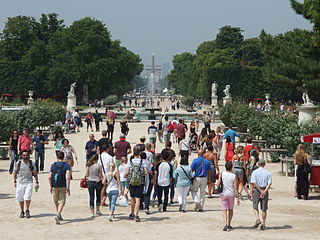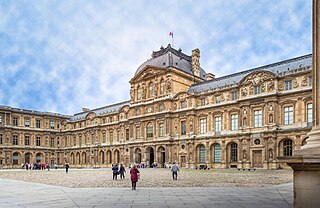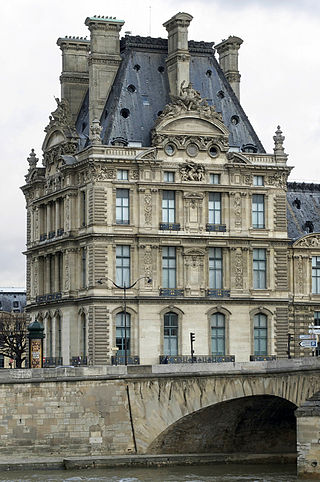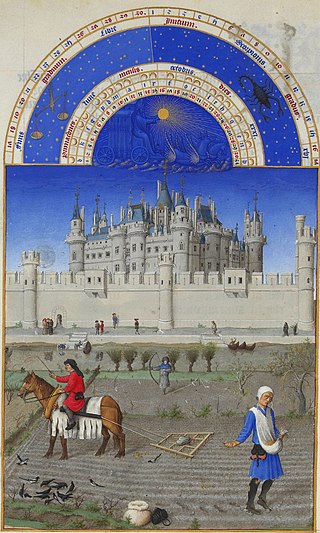
The Louvre, or the Louvre Museum is a national art museum in Paris, France. A central landmark of the city, it is located on the Right Bank of the Seine in the city's 1st arrondissement and home to some of the most canonical works of Western art, including the Mona Lisa and the Venus de Milo. The museum is housed in the Louvre Palace, originally built in the late 12th to 13th century under Philip II. Remnants of the Medieval Louvre fortress are visible in the basement of the museum. Due to urban expansion, the fortress eventually lost its defensive function, and in 1546 Francis I converted it into the primary residence of the French Kings.

Uru-ka-gina, Uru-inim-gina, or Iri-ka-gina was King of the city-states of Lagash and Girsu in Mesopotamia, and the last ruler of the 1st Dynasty of Lagash. He assumed the title of king, claiming to have been divinely appointed, upon the downfall of his corrupt predecessor, Lugalanda.

The Tuileries Garden is a public garden located between the Louvre and the Place de la Concorde in the 1st arrondissement of Paris, France. Created by Catherine de' Medici as the garden of the Tuileries Palace in 1564, it was eventually opened to the public in 1667 and became a public park after the French Revolution. Since the 19th century, it has been a place where Parisians celebrate, meet, stroll and relax.
The Ubaid period is a prehistoric period of Mesopotamia. The name derives from Tell al-'Ubaid where the earliest large excavation of Ubaid period material was conducted initially in 1919 by Henry Hall and later by Leonard Woolley.

The Tuileries Palace was a royal and imperial palace in Paris which stood on the right bank of the River Seine, directly in front of the Louvre. It was the usual Parisian residence of most French monarchs, from Henry IV to Napoleon III, until it was burned by the Paris Commune in 1871.

A ceiling is an overhead interior surface that covers the upper limits of a room. It is not generally considered a structural element, but a finished surface concealing the underside of the roof structure or the floor of a story above. Ceilings can be decorated to taste, and there are many fine examples of frescoes and artwork on ceilings especially in religious buildings. A ceiling can also be the upper limit of a tunnel.

The Louvre Pyramid is a large glass-and-metal structure designed by the Chinese-American architect I. M. Pei. The pyramid is in the main courtyard of the Louvre Palace in Paris, surrounded by three smaller pyramids. The large pyramid serves as the main entrance to the Louvre Museum. Completed in 1988 as part of the broader Grand Louvre project, it has become a landmark of Paris.

The Louvre Palace, often referred to simply as the Louvre, is an iconic French palace located on the Right Bank of the Seine in Paris, occupying a vast expanse of land between the Tuileries Gardens and the church of Saint-Germain l'Auxerrois. Originally a defensive castle, it has served numerous government-related functions in the past, including intermittently as a royal residence between the 14th and 18th centuries. It is now mostly used by the Louvre Museum, which first opened there in 1793.

The Diana of Versailles or Artemis, Goddess of the Hunt is a slightly over-lifesize marble statue of the Roman goddess Diana with a deer. It is currently located in the Musée du Louvre, Paris. The statue is also known as Diana with a Doe, Diana Huntress, and Diana of Ephesus. It is a partially restored Roman copy of a lost Greek bronze original attributed to Leochares, c. 325 BC.

The Port du Louvre is a walkway running along the River Seine immediately to the south of the Louvre in Paris, France. It is parallel to and lower than the larger Voie Georges Pompidou road between it and the Louvre.

The Pavillon de Flore, part of the Palais du Louvre in Paris, France, stands at the southwest end of the Louvre, near the Pont Royal. It was originally constructed in 1607–1610, during the reign of Henry IV, as the corner pavilion between the Tuileries Palace to the north and the Louvre's Grande Galerie to the east. The pavilion was entirely redesigned and rebuilt by Hector Lefuel in 1864–1868 in a highly decorated Napoleon III style. Arguably the most famous sculpture on the exterior of the Louvre, Jean-Baptiste Carpeaux's Triumph of Flora, was added below the central pediment of the south facade at this time. The Tuileries Palace was burned by the Paris Commune in 1871, and a north facade, similar to the south facade, was added to the pavilion by Lefuel in 1874–1879. Currently, the Pavillon de Flore is part of the Musée du Louvre.


Groupe du Louvre is a French company, headquartered in Village 5, La Défense in Nanterre, France. Groupe du Louvre and Louvre Hotels Group was sold to Shanghai Jin Jiang International Hotels Development Co., Ltd. in 2015. The company was owned by the American investment company Starwood Capital Group, following its earlier purchase of Société du Louvre in December 2005. The range of hotel brands was extended in 2009 with the purchase of Golden Tulip Hospitality Group.

The Louvre Castle, also referred to as the Medieval Louvre, was a castle built by Philip II of France on the right bank of the Seine, to reinforce the city wall he had built around Paris. It was demolished in stages between 1528 and 1660 to make way for the expanded Louvre Palace.

The Great Sphinx of Tanis is a granite sculpture of a sphinx, whose date may be as early as the 26th century BC. It was discovered in the ruins of the Temple of Amun-Ra in Tanis, Egypt's capital during the 21st Dynasty and the 23rd Dynasty. It was created much earlier, but when exactly remains debated with hypotheses of the 4th Dynasty or the 12th Dynasty. All that is left of its original inscription are the parts alluding to pharaohs Amenemhat II, Merneptah and Shoshenq I.
Principal Monuments of France is a series of four paintings created by the French artist Hubert Robert in 1786. They depict the ruins of several Roman structures in Provence.

Ishtup-Ilum, also Ishtup-El was a ruler of the city of Mari, one of the military governors known as Shakkanakku in northern Mesopotamia, after the fall of the Akkadian Empire. He was probably contemporary with the Second Dynasty of Lagash, around the time of Gudea. He was the son of Ishma-Dagan and brother of Nûr-Mêr, both Shakkanakkus of Mari before him, and, according to the dynastic lists, he ruled after them for a period of 11 years.

The Pavillon du Roi was a tower-like structure built in the mid-16th century at the southern end of the Lescot Wing of the Louvre Palace. On its main floor was the primary apartment of the King of France. The pavilion served as a major emblem of the French monarchy for more than a century, and its design had seminal influence. From the 17th century, however, it gradually lost its visual and symbolic prominence. In the early 1640s, it was eclipsed by the slightly larger and more ornate Pavillon de l'Horloge; in the late 1660s, its main southern façade was hidden behind new structures; and in the early 19th century, its upper level was demolished and its interior arrangements were entirely remodeled.
















